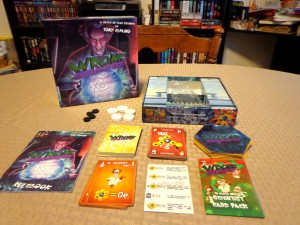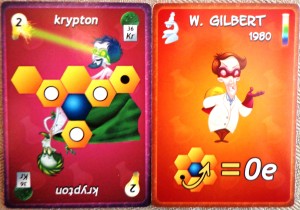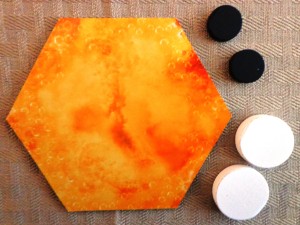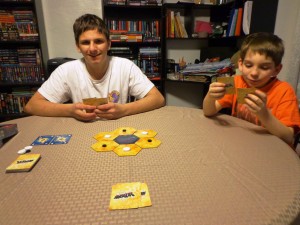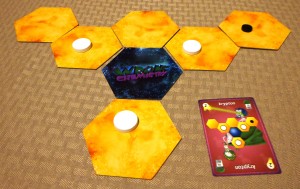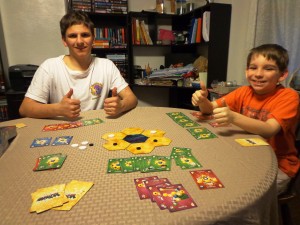“Wrong Chemistry” is a recent Kickstarter success that almost doubled the funding it needed to launch its way into the homes of mad scientists everywhere. It’s a game that tasks players with creating bogus elements (inspired by the real periodic table) in an attempt to score points. Players will be working with the same molecule on the game board, rearranging it however they can to get it to match the elements that they currently have in their hand. Before we begin scrambling atoms, I’d like to thank Alexandros Argyropoulos from Mage Company LTD for sending me a free review copy.
Components
Hexes – There is one blue hex and six yellow hexes, representing the parts of the molecule. The blue hex remains fixed while the yellow hexes can be moved around.
Discs – There are five white discs and four black discs, all of which can be added, removed, and moved from/between the hexes.
Cards – There are a total of fifty-four cards. Fifty-two of them each contain a bogus element closely resembling its real counterpart on the periodic table (Solfur instead of Sulfur, for example). The number inside the light bulb is used for endgame scoring (ideas) and the PTR (periodic table reference) is used for determining the starting player as well as in assigning bonus points for successful runs at the end of the game. Two of the fifty-four cards (restartium and extramovium) are reference cards with special abilities that are utilized by players during the game.
Editor’s Note: I also received ten Mad Scientist cards, which are mixed in with the deck and give players unique abilities during the game. These were given to Kickstarter contributors and will be offered as a separate expansion pack in the future.
Setup & Gameplay
First, the blue hex is placed in the center of the table with the yellow hexes surrounding it on all sides. Six discs are placed on the six yellow hexes (one each) in an equal, alternating fashion (three black, three white). Next, players find the restartium and extramovium cards in the deck and place them face up nearby, along with the extra discs. Finally, the remaining cards are shuffled and each player gets four. Each player then picks a card from their hand, placing it face down on the table until everyone is ready to flip it over. The person with the lowest PTR number (upper right corner of the card) on their card goes first. The cards used are discarded and each player draws one more card.
On a player’s turn, they’ll have enough energy to perform four actions, which can consist of the following:
1. Only once per turn, a player can use the effect of the restartium card to move the hexes back to their original state from when the game was set up.
2. Take a disc off the board.
3. Place a disc from off the board onto an empty hex. (A hex cannot have more than one disc)
4. Move a disc from one hex to another.
5. Move a yellow hex to another location, though it must border at least one other hex. The blue hex cannot be moved.
6. Discard a card from their hand.
7. Play a card that matches the molecule currently present on the table. The card is placed into that player’s score pile. This action does not use energy.
8. Sacrifice a card from their score pile to use the extramovium card, which grants them three extra energy points. This action does not use energy.
At the end of a player’s turn, they draw up to four cards and play continues clockwise. The game ends when a player cannot draw up to four cards. Each player counts the number of points on the cards in their score pile (the numbers inside the light bulbs). Bonus points are scored for any runs made in the process valued at one bonus point per card in the run. The person with the most points wins the game!
The above is simply an overview of the game, but should give you an idea of how it is played. You can view the manual for more information, which is located here:
The Review
The components were sturdy and colorful. I didn’t have any issues reading the text on the cards and moving the hexes / discs around when I needed to. The manual does a good job in explaining the rules and I especially like the inclusion of the actual periodic table towards the end of it, which tells you which elements were and weren’t used in the game. It gave me the chance to explain the periodic table to the boys when they saw it in the manual…horray for education!
While the game mechanics themselves are simple in that you are simply moving things around to match the pictures of the elements in your hand, the scoring mechanics makes one think about which elements they should really be going after. One strategy might be to just score anything you can and hope that the LTR numbers form a run. Another strategy is to concentrate on runs while bypassing obvious avenues of opportunity with the intent on scoring as many bonus points as possible. It all comes down to what cards you end up getting and what you’ve already scored, though the option to discard cards is a way to possibly gain the cards you need for a run at the risk of quickly depleting the deck with no points to speak of. It’s an interesting balance that I found to be challenging as I never knew what cards I might get at the end of my turn.
I thought that the game was very well-balanced. It was easy to use the restartium ability in order to reset things and score those easy one point cards. It took a lot more work to score those two and three point cards, as it should be. This opened up more options for us during our play session. I concentrated on scoring those one point cards while Anthony (16) made use of the extramovium card to try and form those the complicated chains that would net him three points. I waited for opportunities to present themselves rather than sacrifice points from my score pile. Vinnie (11) was mainly scoring the one point cards, as their designs were easier to envision in his little mind. After a few rounds, Vinnie caught on to how the play mechanics worked and was quickly scoring points on his own. In the end, I won by a little bit, but it was a close call.
Overall, “Wrong Chemistry” is one of those games that has a simple theme but can provide hours of entertainment. Its quick play time allows players to squeeze a game in on a busy night and the scoring mechanic will keep players thinking as to what cards they will ultimately play. Both Vinnie and Anthony thought the game was fun and as an added bonus, learned a few things about Chemistry that they hadn’t known before: that yes, einsteinium is an actual element and no, there is no better pickup line than, “did anyone ever tell you that you’re as sweet as C6H12O6?” They didn’t get it.
Final Verdict: 7/10
—
—
You can learn more about “Wrong Chemistry” by visiting the following websites:

